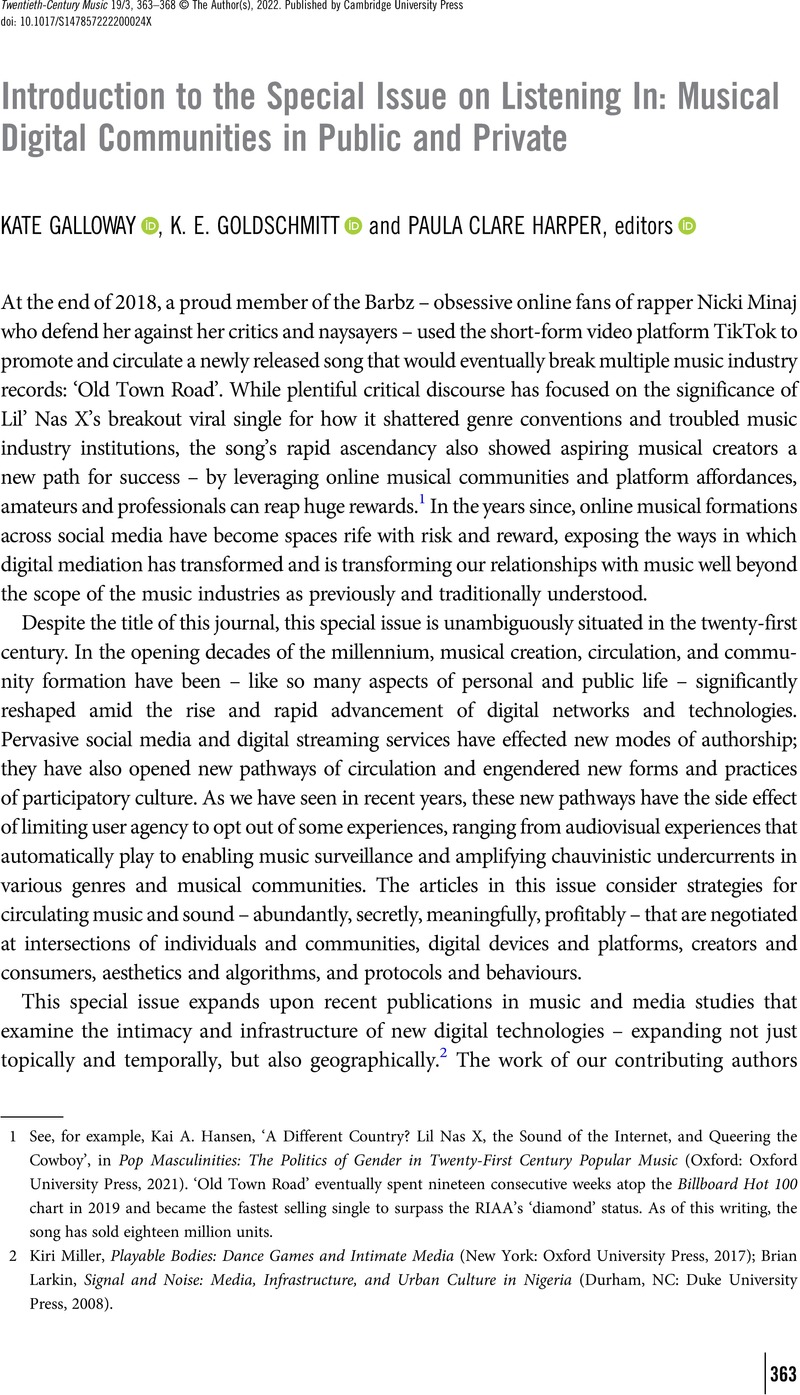No CrossRef data available.
Article contents
Introduction to the Special Issue on Listening In: Musical Digital Communities in Public and Private
Published online by Cambridge University Press: 28 November 2022
Abstract
An abstract is not available for this content so a preview has been provided. Please use the Get access link above for information on how to access this content.

- Type
- Introduction
- Information
- Twentieth-Century Music , Volume 19 , Special Issue 3: Listening In: Musical Digital Communities in Public and Private , October 2022 , pp. 363 - 368
- Copyright
- Copyright © The Author(s), 2022. Published by Cambridge University Press
References
Berland, Jody. Virtual Menageries: Animals as Mediators in Network Cultures. Cambridge, MA: MIT Press, 2019.CrossRefGoogle Scholar
Bronfman, Alejandra M. Isles of Noise: Sonic Media in the Caribbean. Chapel Hill, NC: University of North Carolina Press, 2016.CrossRefGoogle Scholar
Brueck, Laura, Smith, Jacob, and Verma, Neil. Indian Sound Cultures, Indian Sound Citizenship. Ann Arbor, MI: University of Michigan Press, 2020.CrossRefGoogle Scholar
Gopinath, Sumanth. The Ringtone Dialectic: Economy and Cultural Form. Cambridge, MA: MIT Press, 2013.CrossRefGoogle Scholar
Hansen, Kai A. ‘A Different Country? Lil Nas X, the Sound of the Internet, and Queering the Cowboy’, in Pop Masculinities: The Politics of Gender in Twenty-First Century Popular Music. Oxford: Oxford University Press, 2021. 66–99.Google Scholar
Ingham, Tim. ‘It's Official: New Music Is Shrinking in Popularity in the United States’. Music Business Worldwide, 18 July 2022. www.musicbusinessworldwide.com/its-official-new-music-is-shrinking-in-popularity-in-the-united-states/ (accessed 20 July 2022).Google Scholar
Kassabian, Anahid. Ubiquitous Listening: Affect, Attention, and Distributed Subjectivity. Berkeley, CA: University of California Press, 2013.CrossRefGoogle Scholar
Larkin, Brian. Signal and Noise: Media, Infrastructure, and Urban Culture in Nigeria. Durham, NC: Duke University Press, 2008.Google Scholar
Marshall, Wayne. ‘Treble Culture’, in The Oxford Handbook of Mobile Music Studies, vol. 2, ed. Gopinath, Sumanth and Stanyek, Jason. New York: Oxford University Press, 2014. 43–76.Google Scholar
Miller, Kiri. Playable Bodies: Dance Games and Intimate Media. New York: Oxford University Press, 2017.CrossRefGoogle Scholar
Quiñones, Marta G., Boschi, Elena, and Kassabian, Anahid. Ubiquitous Musics: The Everyday Sounds That We Don't Always Notice. Burlington, VT: Ashgate, 2013.Google Scholar
Radano, Ronald, and Olaniyan, Tejumola. Audible Empire: Music, Global Politics, Critique. Durham, NC: Duke University Press, 2016.CrossRefGoogle Scholar
Shaw, Lucas. ‘Pink Floyd Is Seeking $500 Million for Music Catalog Including “The Wall”’. Bloomberg.Com, 23 June 2022. www.bloomberg.com/news/articles/2022-06-23/pink-floyd-songs-for-sale-in-possible-500-million-deal (accessed 20 July 2022).Google Scholar
Shipley, Jesse W. ‘Transnational Circulation and Digital Fatigue in Ghana's Azonto Dance Craze’. American Ethnologist 40/2 (2013), 362–81.CrossRefGoogle Scholar
Steingo, Gavin. Kwaito's Promise: Music and the Aesthetics of Freedom in South Africa. Chicago: University of Chicago Press, 2016.CrossRefGoogle Scholar
Steingo, Gavin, and Sykes, Jim, eds. Remapping Sound Studies. Durham, NC: Duke University Press, 2019.Google Scholar
Wolfson, Sam. ‘Harry Styles Headlining Coachella Is a Triumph of Music's Influencer Era’. The Guardian, 15 January 2022. Music Section. www.theguardian.com/music/2022/jan/15/harry-styles-headlining-coachella-music-festival-influencer-era (accessed 20 July 2022).Google Scholar





